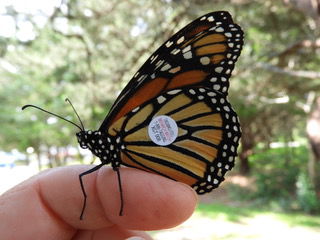Photos used in video provided by Kim Crafts.
CAPE MAY POINT – Calling it one of the “great wildlife spectacles of North America,” the director of the New Jersey Audubon’s Monarch Monitoring Project said it’s important to monitor the butterflies, whose population has declined over the years, as they are the “canary in the coal mine when it comes to insect health.”
Researchers will be driving cars slowly along a five-mile route near the Cape May Bird Observatory three times per day through October, tracking and tallying the insects, according to Mark Garland, director. Rather than trying to count all the monarchs moving through Cape May, their methodology uses sampling criteria to gather the data reflecting “relative annual numbers.”
Monarch butterflies, the regal pollinators that weigh just half of a gram (that’s .017 ounce) and are known for their glimmering orange-and-black wings, have embarked on an annual journey to Mexico of several thousand miles.
Along the way, many will pass through New Jersey, drawing tourists to the Cape May area and providing New Jersey Audubon researchers with an opportunity to measure their numbers and activities during September and October.
“All Monarchs observed are tallied, but no stops are allowed to count specific concentrations,” Garland said.
The route passes through a variety of habitats including southern hardwood forest, agricultural fields, brackish wetland meadows, suburban neighborhoods and coastal dunes along the Atlantic Ocean and Delaware Bay.
“The migration that the monarch butterflies undertake is really one of the great wildlife spectacles of North America,” he said. “We also know that as the monarch goes, so goes other insects. The monarch is no doubt something of a canary in the coal mine when it comes to insect health. We carefully track them.
“Because this sampling occurs each year, it provides researchers with a remarkable long-term data set to track an important population,” he added.
Over the past 25 years, the number of butterflies had fluctuated, from about 66 per hour in 1999 when the monitoring project began, to about 15 an hour in 2016.
The highest number seen in Cape May Point since the project began was in 1999 when about 360 Monarchs were seen hourly during the nine-week program. The lowest was in 2004 when nine were seen per hour over the two months.
“1999 was extraordinary, and we don’t really know why,” Garland admitted, “but monarchs, like many insects, have a very high reproductive potential and wild fluctuations in population size, which are not all that unusual for creatures with this characteristic.”
How climate change is affecting the monarchs is “hard to say for sure,” according to Garland, “but climate change leads to more frequent severe storms, which occasionally cause high mortality to monarchs at the Mexican overwintering sites. Climate change can also change habitats, which can impact all sorts of wildlife.”
As researchers work daily to track and tally the insects, Garland said the program will also provide the “curious with a chance to learn more and, if they’re lucky, even see some caterpillars emerge from their chrysalides as Monarchs.”
Equally important is the group’s campaign to track individual monarchs. Researchers place tiny adhesive tags on their wings. If they encounter these butterflies again, the compiled data offers critical insights into the direction and speed of the migration.
“We catch monarchs with nets, usually as the butterflies visit flowers to feed on nectar,” Garland said. “Much of our work is done at private gardens in Cape May Point, where homeowners have invited us into their gardens to do our work.”
Monarchs go south to Mexico in a single generation, whether they originate from Maine, Minnesota, Oklahoma, Georgia, or anywhere in between, according to Garland. Their urge to mate is suppressed until after they’ve gone through winter dormancy. They break dormancy in March and go north to the southern edge of the U.S., where they reproduce.
“Their offspring spread out and some go as far north as milkweed grows, which is southern Canada,” he noted. “There are two to four more generations that pass during summer, but all monarchs emerging from chrysalides as adults after mid-August become the next generation to head to Mexico.”
Milkweed is the essential food for monarch caterpillars.
Last year, researchers tagged 3,592 monarchs, most of them at Cape May Point. Since the project began, New Jersey Audubon staffers have recovered 70 tagged butterflies in Mexico.
“Each one that’s found in Mexico represents many, many more,” Garland explained. “We also found that most stay east of the Appalachian Mountains and then near southern Georgia and northern Florida. They make a right-hand turn and follow the Gulf coast to Texas, and from there they beeline it to the mountains of Mexico.”
In one case from 2008, a butterfly tracked in Cape May traveled 558 miles to Georgia in just three days.
The Monarch Monitoring Project also undertakes an educational outreach campaign. New Jersey Audubon hosts dozens of public programs each fall, teaching thousands about Monarchs, how they are tagged and how people can grow butterfly gardens to nurture the insects.
In addition, supporters can adopt a tagged monarch butterfly for a $25 contribution, which is used to support the Monarch Monitoring Project.
New Jersey Audubon project maintains a terrarium stocked with caterpillars at the Cape May Bird Observatory, Northwood Center, Cape May Point.
There, guests can watch the insect run through its life cycle, including when it emerges from its chrysalis if the timing is correct.
Questions about the program can be emailed to monarchs@njaudubon.org or by calling 609-400-3868.
To contact Karen Knight, email kknight@cmcherald.com.
Cape May County – Hakeem Jeffries, the house minority leader keeps saying “ we must stop MAGA” Biden calls MAGA a “ dark force” and democrats keep pushing Jan. 6 as “ the insurrection” .It is not hard to see how the…








